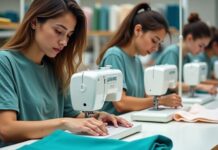The resale industry has thrived despite economic volatility and shifting customer tastes. ThredUp’s 2017 Resale Report shows a major shift in retail, with consumers increasingly preferring secondhand clothing. The sector adapts to new technology, government restrictions, and buyer behaviour as it recognises resale’s disruptive potential.
1. Global and US Market Size
The analysis estimates that the worldwide used clothes market would reach $367 billion by 2029. This is 2.7 times the global apparel market’s growth rate. In 2024, secondhand clothes accounted for 9% of worldwide garment spending and grew 15%. The U.S. market alone grew 14%, five times faster than the entire retail clothes market.
A 9% CAGR is anticipated to boost the U.S. secondhand clothes market to $74 billion by 2029. The incremental secondhand spending is predicted to be 60% driven by new customers, with younger generations aged 18-44 accounting for 68% of this rise.
2. Buyer Trends
The report shows a record amount of customers buying used goods online, 58%. With 56% of younger shoppers selecting secondhand clothing, the preference has grown. Secondhand shopping is appealing for its price, sustainability, and unique fashions.
The top five reasons customers buy used clothes are:
Better deals
The excitement of hunting
High-end brand affordability
Environmental concerns
Looking for unique looks
58% of secondhand transactions are made online, with organised markets and social media gaining popularity.
3. Tariff/Trade Effects
80% of retail executives expect global supply chain disruptions as they handle tariffs and trade regulations. To reduce volatility, many are considering secondhand solutions. The survey predicts that 62% of consumers, particularly younger generations, would buy secondhand clothing if new policies raise prices.
4. Seller Trends
Sustainability is becoming more important in clothing purchases, with 42% of shoppers considering resale value. Reselling products is making previous buyers more selective, with 26% cutting back on lower-quality clothing due to resale worries.
In 2024, 27% of consumers tried to sell their old or unwanted clothes, with younger generations averaging 52%.
5. Branded Resell
With 82% of executives saying customers are already engaging in branded resale, retailers are seeing demand. However, 86% of non-participating executives are unaware how to establish resale programs. However, branded resale initiatives are gaining popularity due to their potential to acquire customers and generate cash.
6. The Future of Social Commerce
Social commerce is changing shopping, especially for young people. In the past year, 39% of younger customers bought secondhand clothing on social media. Retail executives believe social commerce will boost customer engagement and revenue, with 76% recognising its value.
7. AI’s Impact
AI is altering resale. AI-powered solutions are being used to personalise and streamline the purchasing experience for 30% of buyers intimidated by the wide assortment of used things. AI makes secondhand buying easier, so retailers hope it will increase adoption.
8. Govt Support
The paper recommends government support for the secondhand market as part of sustainability efforts. Textile waste policies and circular fashion are supported by 78% of retail executives who value new business concepts.
Conclusion
According to the 2025 Resale Report, customer behaviour towards secondhand clothing is changing rapidly. Retail leaders have unique opportunity to incorporate resale into their business strategies as this trend grows. Reselling has a bright future thanks to AI, social commerce, and supporting government legislation. As ThredUp CEO James Reinhart puts it, this report gives us a newfound purpose and drive to improving the apparel sector, signalling a turning point in retail.
































